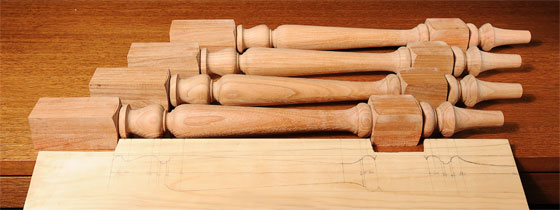|

Robert McKee has been teaching woodturning and joinery to adults for over 25 years. Originally he trained as a wood machinist, but relatively early in his career he discovered that teaching was the thing that really motivated him.
After many years as a teacher within the TAFE system in Queensland and also in the private sector, he still gets great satisfaction from passing on knowledge and seeing how people grow in confidence and ability with a little guidance in the right direction.
Here he takes Carol Russell through the process of making a drawing template and explains how to use it as a reference to turn four identical table legs.
Making the Template
Turning a single leg and getting the design you want is one thing, but to make the other three look the same can be tricky. A hand turned set of legs will always have some variation from leg to leg - this is part of the charm of a handcrafted table. However in order to look professional, they needs to be as close in appearance as they can be.
The best way to achieve conformity in your spindle turning is through the use of a drawing template. This is an effective method to record and replicate all the measurements and details of your leg design.
A piece of straight, flat plywood works well for a template. The thickness isn’t imperative - about 10mm is good. Mark out the length of the legs and draw a centre line to work from along the length. You begin by drawing only half of the profile of the leg. Once you have settled on the design you can draw the other side of the profile.
Either design the leg from scratch, or if you have an existing table leg you like the shape of, transpose some of its features onto your template to form the basis of the new design. In this case Robert had a leg design that suited us well, but it was larger in diameter than our timber allowed for. He modified the measurements to suit.
Carefully measure and mark the points where you want features such as coves or beads to be. Mark the distance between them and also the diameter required at each of these points. Record all the measurements on the template as well. You will need to use a bit of imagination to draw your leg design and give it the style you require for your project.
The lines on the template that illustrate where the details are to go will be later transferred to your rounded leg blanks, as they spin on the lathe, by holding the template against the blank and fitting a pencil into a small groove that has been filed in the template at the points where the coves or beads are located.
Preparing The Timber
The plan for our project is to make a traditional hall table from New Guinea Rosewood with turned legs and a shelf near the bottom. The legs and rails will be mortised and tenoned. The turned legs will have an additional square section at the bottom for cross rails that will support the shelf. The timber is square dressed to 60mm x 60mm and cut to a length of 750mm.
Robert marks the centres with a marking gauge from all four sides. This will reveal if the blanks aren’t square. he uses an awl to pinpoint the exact centre.
The rails for the table will be 120mm wide, so he leaves a square shoulder of 135mm, allowing for the corners to be rounded back about 5mm.
The leg blanks are fitted onto the lathe and Robert uses a skew chisel to separate the sections that will be left square from the section to be rounded off. He rounds the edges of the shoulder over slightly and roughs out the rest of the leg blanks.
The square section can be cut out of the template to enable it to sit right up against the leg. This is the point where the marking-out lines can be transferred onto the leg.
A series of calipers pre-set to the range of diameters that feature in the leg design will ensure uniformity across all four legs.
Providing the template is used as the reference for each leg and the measurements are strictly adhered to, the four legs should be the same.

The great thing about taking the time to make high quality templates is that you will have them on hand to use for many years to come. Eventually you’ll accumulate an extensive collection that will save you both time and energy.
Robert McKee is the Director of the RM School of Woodworking Pty Ltd, he conducts classes from the Woodturners Society of Qld workshop at Greenslopes.
Keep and eye out for the Hall Table Project, coming soon!
|